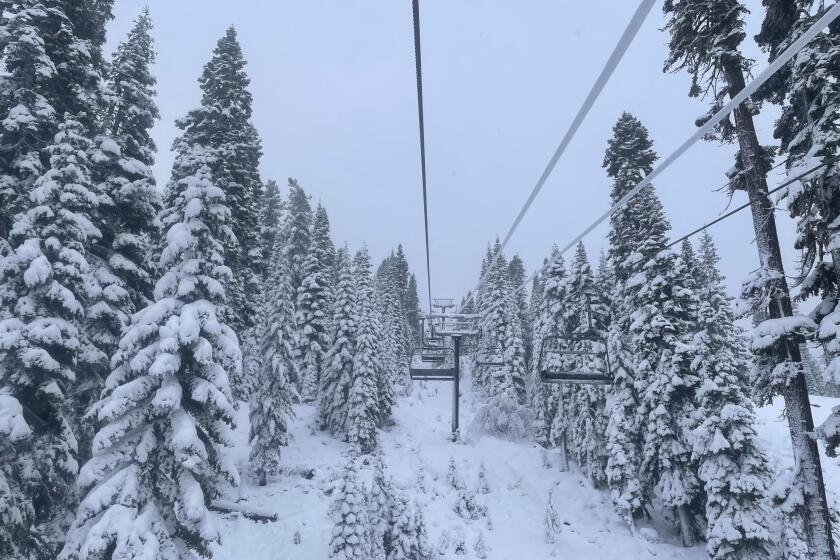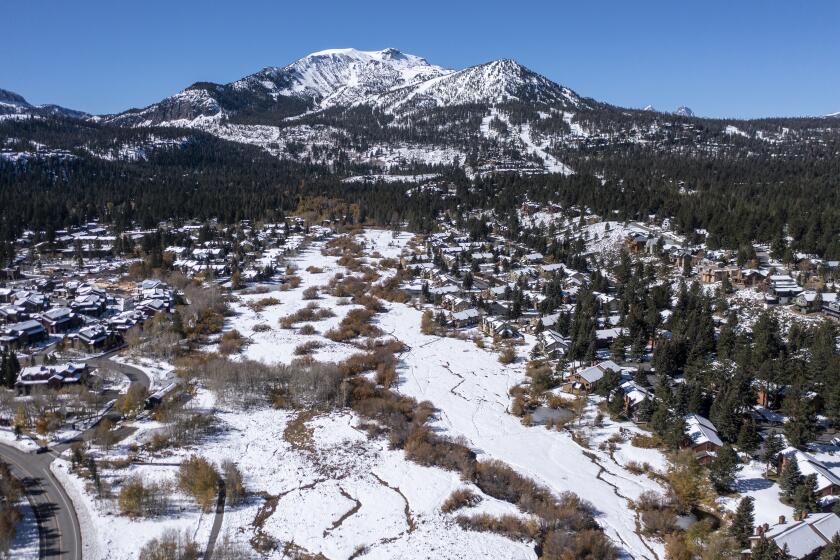Record-breaking Sierra snow buries towns, closes highways
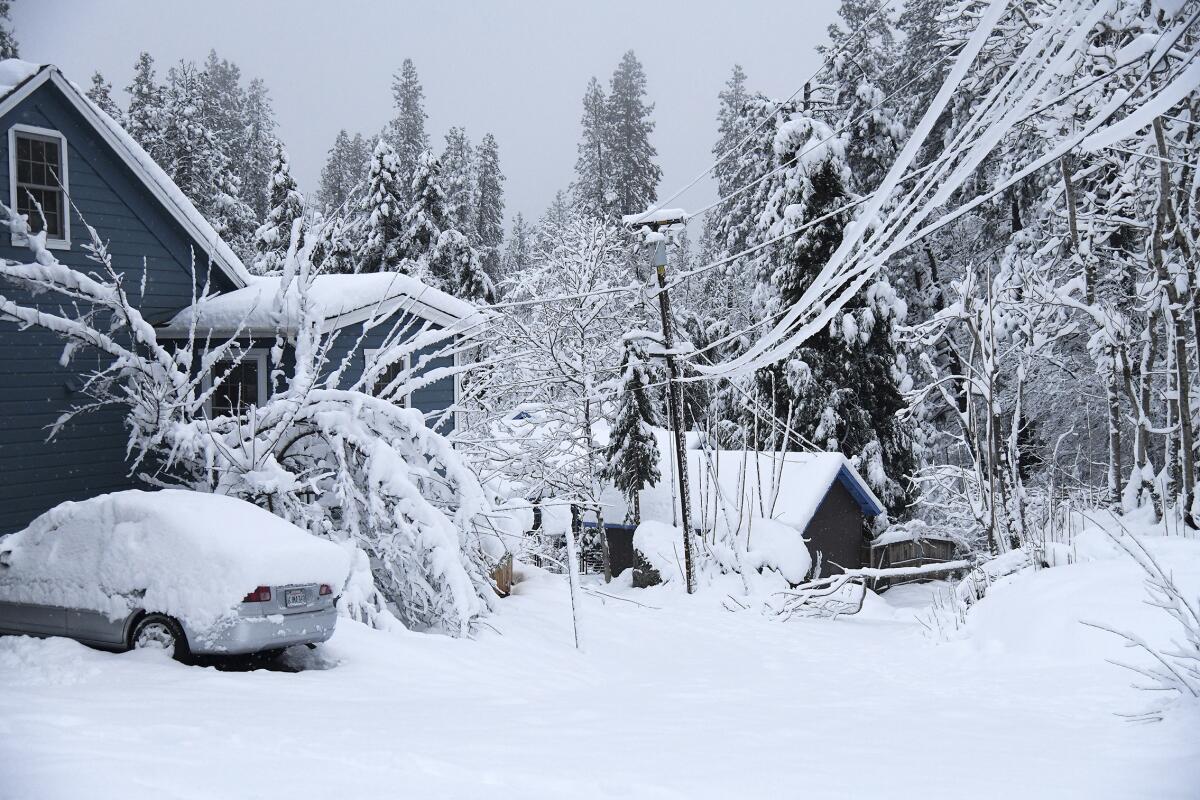
- Share via
COLFAX, Calif. — “Snowbound” was not a term Stephen Kulieke thought he would hear at the end of California’s driest year in a century, but that’s precisely the position the Sierra City resident found himself in this week.
“It’s snowmaggedon,” said Kulieke, 71, whose mountain cabin was buried under at least 4 feet of powder Monday amid record-breaking snowfall in the Sierra Nevada. “It’s just beyond belief how much snow there is.”
Officials at the UC Berkeley Central Sierra Snow Lab at Donner Pass said the area’s snowfall totals have surpassed the previous December record of 179 inches set in 1970. By Tuesday morning, the lab had received a whopping 202.1 inches of snow, making it the third-snowiest month on record.
The snow comes as a much-needed surprise for the bone-dry West, where only months ago, officials put residents under a state of drought emergency amid increasingly dry conditions. During the long, hot summer, rivers and reservoirs dried up, and once-green fields sat fallow and turned to dust.
But December roared in like a lion, with back-to-back storms dumping up to 15 feet of snow across the Sierra Nevada and other mountain areas of California, prompting road closures and snarling holiday travel. Though experts wouldn’t go so far as to call it a drought-buster, they said every bit helps.
“It’s a great start,” said Mike Anderson, state climatologist at the California Department of Water Resources. “It alleviates the worst of the conditions that had accumulated, but it doesn’t cure everything. We really need this to continue into the new year.”
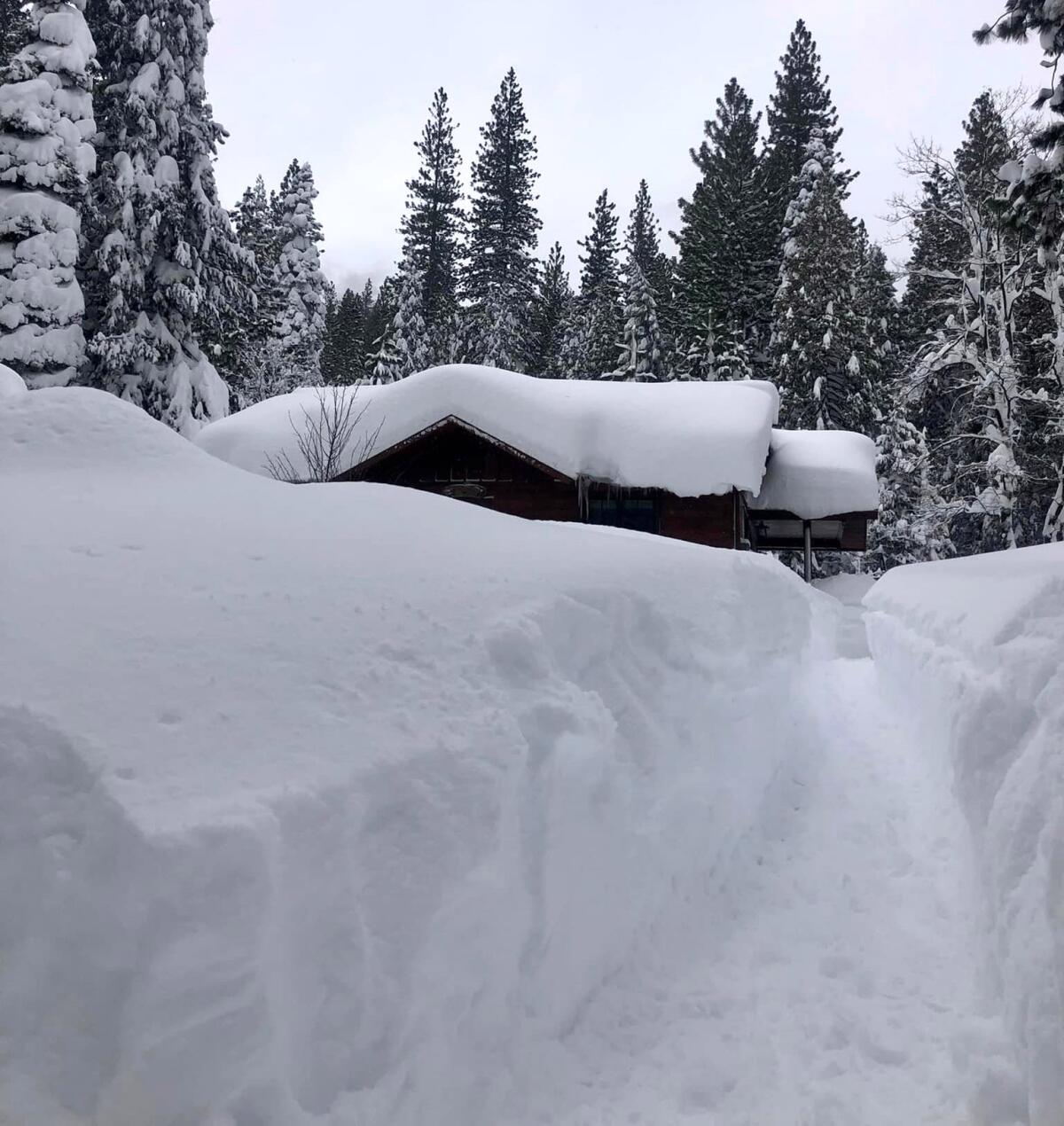
Andrew Schwartz, the station manager and lead scientist at the Berkeley snow lab, agreed, noting that “cautious optimism is the name of the game right now.”
According to Schwartz, the month’s earlier storms were driven by a high-pressure system sitting off the coast of California. Another high-pressure system off Alaska has been “slinging moisture” at the state this week.
The result is that snowfall at the lab since Oct. 1 — the start of California’s water year — is at 258% of average, he said. Almost all of it came in December.

Though welcome, the snowfall has also proven dangerous.
Conditions have hampered search and rescue efforts for a missing 43-year-old ski shop worker in Truckee, Rory Angelotta, who was last seen heading out to ski on Christmas morning. There have been rockfalls, road closures and multicar pileups as the latest storm barreled through the state from north to south.
Highway 50 near South Lake Tahoe was backed up and “at capacity” Tuesday, officials with the California Department of Transportation said. Residents were urged to stay home or face delays of up to 10 hours.
Other highways were completely blocked, including Interstate 80, which was closed much of the day Tuesday from Colfax to the Nevada state line until some eastbound lanes reopened in the afternoon.
In South Lake Tahoe, officials activated the city’s emergency operations center and warned drivers against unnecessary travel. They warned that basic services — gas, tow trucks and lodgings — were strained or overwhelmed. “With the highways also at capacity, there are significant delays in travel time.”
Drivers risk running out of fuel or depleting their batteries and becoming stranded, according to the statement.
“Emergency vehicles, snowplows and their staff are challenged with getting through the traffic, so assistance may be delayed,” officials said.
Electric vehicle drivers are encouraged to look up charging stations closest to them, officials said.
“Because of road conditions and limited ability to get supplies, all resources within the city are currently limited and will likely remain so until conditions improve,” officials said.
At Marval’s Sierra Market in Colfax, store manager Jeremey Rogers and supervisor Barrett Deveraux watched drivers navigate the unplowed parking lot.
“This is pretty gnarly,” Deveraux said of the storm, which toppled trees and threatened to dump more snow later in the day.
A steady stream of shoppers flooded the store, leaving with bread, water and beer. Several locals said spotty cell service was preventing them from making calls. The market was out of propane and low on bread, but Rogers said he expected to have enough diesel to run the generator until more supplies arrived.
“I slept here at the store last night,” said Rogers, who lives in Alta Sierra, northwest of Colfax, where his home was also without power. “I might have died on my way home.”
The search for a skier missing since Christmas Day amid whiteout conditions at a Northern California ski resort continued Monday.
Those hitting the highways encountered blockades amid hazardous conditions, with some expressing concern that mapping software was sending drivers onto dangerous, poorly maintained mountain roads in efforts to avoid closures.
On Tuesday, weary travelers and locals pulled into a Valero gas station south of Colfax off I-80’s Applegate exit in hopes of snacks and fuel. But with no power, the pumps were off and the station closed.
“We haven’t had power since yesterday morning,” said Zach Stein, 33, who lives in nearby Weimar. “There are downed trees and power lines.”
Erin Morgan and her husband, Jaime Labeiga, were trying to get to a rental house in Truckee with Labeiga’s sister and her boyfriend, who had never seen snow before.
They knew they were unlikely to make it when they left the Bay Area, but as they drove past Auburn and continued east on I-80, their hopes began to rise.
“We were driving and there was no snow, no snow, and then bam,” Morgan said.
With cars being turned around, the four pulled over at the gas station for a snowball fight and to take pictures with a deserted snowman.
“Clearly, we weren’t the only ones with this idea,” Morgan said. “I guess we will just head back after this.”
New research has found that winters of low snow, or even no snow, could become a regular occurrence in California in as little as 35 years.
The record snow is still only a start for California, which has to make up for a massive moisture deficit before it can chip away at the drought, Schwartz said. Though snowfall for Tuesday was high at the snow lab, it still was only about 68% of what the state expects each year.
“It’s definitely amazing that we’ve been able to break this record, but ultimately, we can’t really depend on it to do anything to the drought just yet,” Schwartz said.
Earlier this year, researchers at the Lawrence Berkeley National Laboratory found that climate change was contributing to dwindling snowpack across the state and that winters of low snow, or even no snow, could become a regular occurrence in California in as little as 35 years.
Anderson, the state climatologist, said the recent snow is tied to shifting weather patterns, but it doesn’t necessarily alter the long-term climate outlook.
“The good news is December came through the way we needed it to in terms of delivering rainfall and developing snowpack,” he said. “It also fits into that narrative that as the world warms, there’s more extremes, more variability. So when you do get these events — boy, they really come in.”
Whether the current deep snowpack will last until the spring and summer — when the state’s water regulators typically lean on it as a critical source of supplies — depends on several factors, including temperatures, wind and sun, he said. But there’s no denying that it made a difference.
“If December ends up being our whole winter, if that’s the case, then thank goodness it was such a big one,” Anderson said, noting that statewide reservoirs made some gains this month.
The latest outlook from the National Oceanic and Atmospheric Administration also points to drought improvements for large parts of the Central Valley, he said, although drought conditions are likely to persist in much of Southern California.
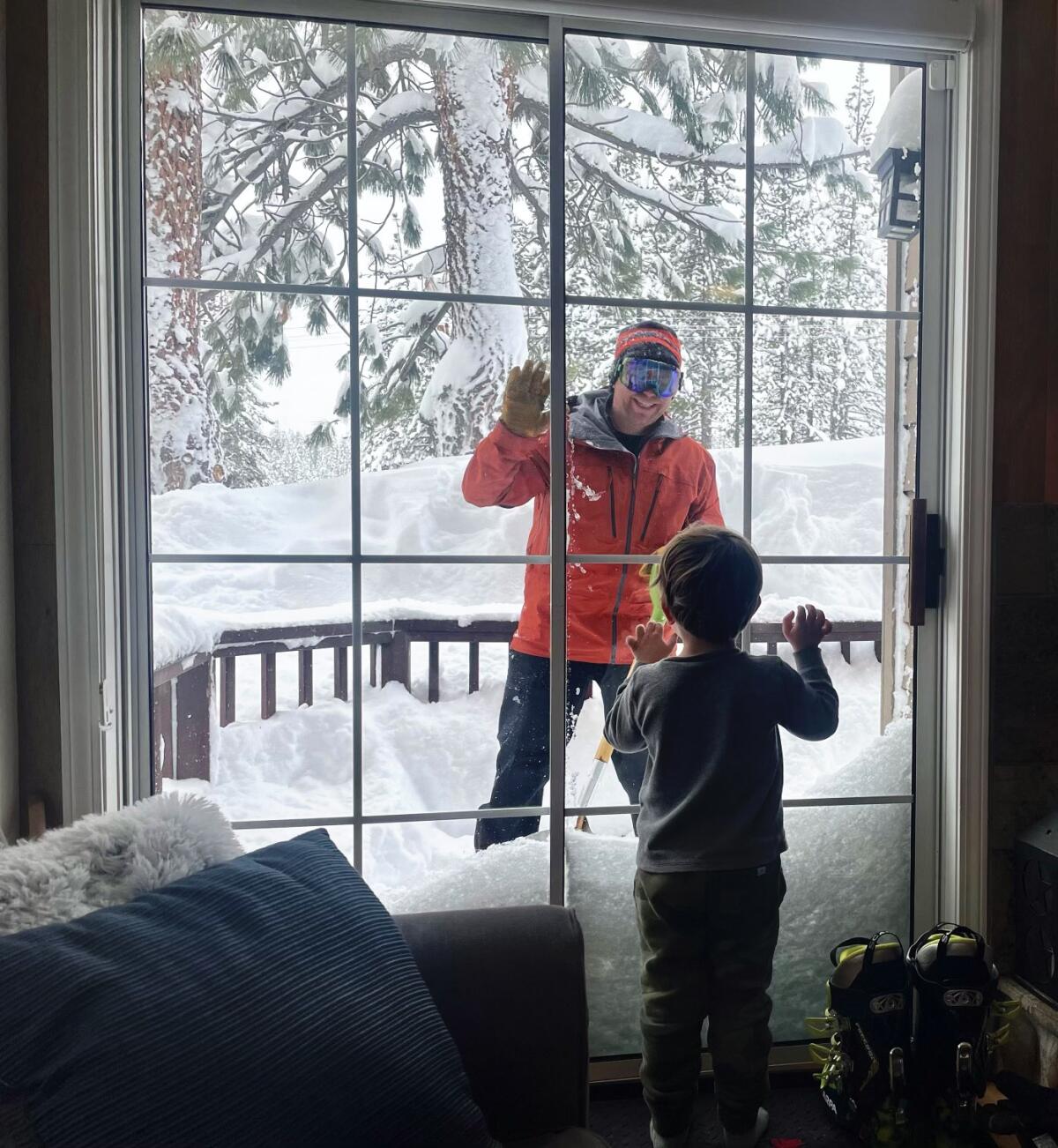
For residents like Jared Abelson, an avid skier with a home in the Tahoe Donner neighborhood of Truckee, the waist-high snow was cause for celebration.
“This is probably one of the best things that could happen to the state after the drought,” said Abelson, 39. “Most of our water comes from Sierra snowmelt, so we need this. Especially after the dry November. I live for this stuff.”
Abelson said he made it to a grocery store in Truckee on Sunday, which was running on a generator and had been nearly picked clean of supplies. He was able to secure enough provisions to hunker down at the house with his family of eight, including his wife, children and in-laws.
But temperatures quickly dropped into the teens and single digits as a storm hit Sunday night, and electricity in the area was intermittent, he said. Everyone gathered around a small fireplace that had already been running for four days straight.
“We hung blankets in front of the windows, put towels around the door jambs and put other blankets on the floors just trying to keep the heat in,” Abelson said.
Still, he was glad for what the snow means for California, and said the family was passing the time playing with the kids, ages 4 and 8 months, and snowshoeing and shoveling.
His excitement will likely be met with even more snow: The National Weather Service on Tuesday said another storm was rolling in this week. Winter weather watches and storm advisories will be in effect in the Sierra and other mountain areas intermittently through week’s end, officials said.
Some, like Kulieke in Sierra City, are glad for the moisture. A columnist for the weekly Mountain Messenger newspaper, he said he spent 10 straight weeks this year writing about wildfires, including the Dixie fire, which burned nearly 1 million acres not far from where his cabin now sits beneath a mountain of snow.
“What’s the old expression? Look out what you ask for — you might get it,” he joked.
The small community where he and his husband, Jeff, spend much of their time has been impassable for days, and electricity has been intermittent. He was using a generator to power his cellphone and refrigerator, and a fireplace to keep the house warm.
His husband has already trounced him in Scrabble several times, he said, so he was passing the hours in his study working on his next column for the paper, which will be a reflection on the events of 2021.
“It’s daunting how both nature and a pandemic can bring us to a standstill,” he said as he watched the steady snow falling outside his window. “We’re going into a new year in a way that we didn’t anticipate, and it has challenges and also opportunity. And that’s a good metaphor for our lives generally right now.”
Times staff writers Mark Z. Barabak, Stuart Leavenworth and Gregory Yee contributed to this report. Gutierrez reported from Colfax, Calif., and Smith from Los Angeles.
More to Read
Sign up for Essential California
The most important California stories and recommendations in your inbox every morning.
You may occasionally receive promotional content from the Los Angeles Times.
